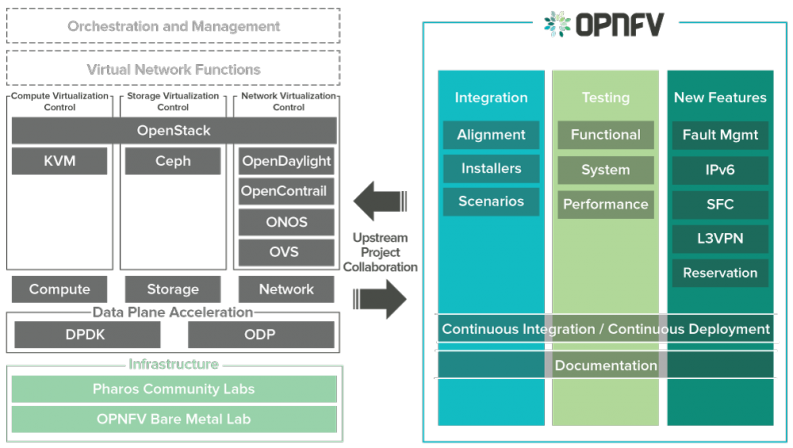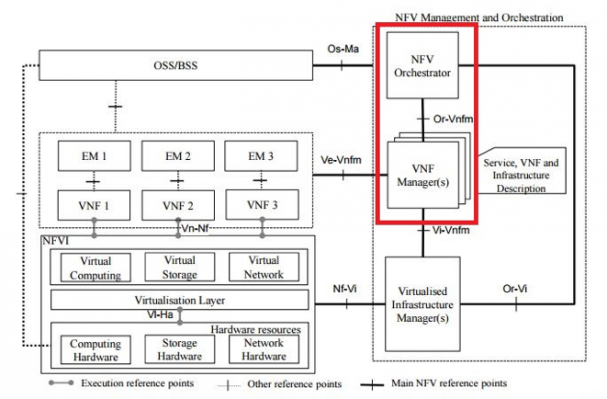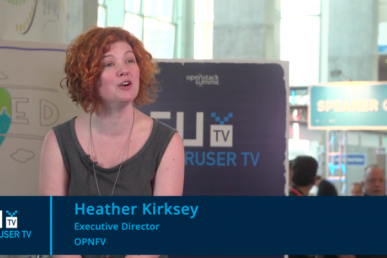The Open Platform for Network Function
Virtualization (OPNFV) is a 2-year-old Linux
Foundation project that offers an integrated, installable
open source NFV solution. OPNFV
combines OpenStack and over 30 additional
selectable components and enhances
them with carrier-grade features. End users
can download their choice of installer, operating system,
and SDN controller to quickly deploy a tested platform
backed with a thriving open
source community. The
project teams have worked together on key deployment
scenarios that are automatically installed, configured, and tested. A
key premise of the OPNFV community is
“upstream first”
meaning OPNFV community members have actively
contributed to blueprints and code for many OpenStack projects as well
as KVM, OpenvSwitch, OpenDaylight, and the Linux
kernel. OPNFV expands the OpenStack community and the
“carrier-grade” philosophy actually improves OpenStack for all users,
especially in performance, resiliency, and scaling geographically. The
two projects are in close contact at all levels.
The diagram below shows the
relationship between OPNFV projects and the many upstream projects
collaborated with.

New Features
=========================
The Arno release of OPNFV came out in June 2015 and was based on
the OpenStack Juno version. Can you tell that
we’re using the names of rivers for our releases? With the
March 2016 release of
OPNFV, Brahmaputra jumped past Kilo and went
straight to the current OpenStack Liberty
release, which enhances the platform with
needed carrier-grade
features such as:
- Choice of installer and operating
system
technology - IPv6 router deployment and improvements in the Linux
kernel - Significantly improved fault detection and recovery
capabilities via work in OpenStack Neutron,
Ceilometer, and Monasca - Service Function Chaining (SFC)
capabilities for Virtual Network
Functions (VNFs) - Layer 3 Virtual Private Networking (VPN) instantiation and
configuration - Basic resource reservation via a shim layer on top of
OpenStack - DPDK performance enhancements for
Open vSwitch and the KVM hypervisor
- In addition to the default OpenStack networking
options, OPNFV supports installation and
functional Tempest tests using various SDN
controllers such as OpenDaylight,
ONOS from
ON.Labs, and OpenContrail.
The Brahmaputra release of OPNFV includes support for
four different bare-metal installers for OpenStack:
- APEX,
which is RDO with Triple O and Puppet. Supports
CentOS. - Compass,
which relies on Ansible to install OpenStack and other components.
Supports Ubuntu (CentOS support is coming soon). - FUEL, which
integrates the OPNFV features with
the<span
class="c11">Fuel stack
installer/deployer.
Supports Ubuntu - JOID, which
uses MaaS
and JuJu from Canonical.
Supports Ubuntu.
Put this all together and you get a matrix of 16 different
platform combinations to consider! OPNFV Project <span
class="c0">Genesis (GENEral
System Install Services) aims for a common user experience.
Genesis specifies what
components are included to make up an OPNFV environment such as which
version of OpenStack, OVS, etc.
The <span
class="c0">Pharos project
specifies the networking and server hardware a lab would need to build
out for a typical deployment configuration. There’s a
pod concept with 6 physical servers where the
first node acts as a jump box to pxe boot the other 5. That’s 3
controller nodes and 2 for compute in a highly
available (HA) configuration.
There are 12 different Pharos
labs each one with multiple pods each from different
companies contributing resources for integration and testing the various
combinations of components. The pods are fairly static today with a
fixed jump host for the designated installer and a network design using
a specific layout of VLAN trunk and access ports. In future versions of
OPNFV the network will be dynamically configured during each build.
The six servers that make up a pod are controlled with <span
class="c0">Jenkins<span
class="c0">Job
Builder scripts
stored in the OPNFV Gerrit repository. The OPNFV core
release engineering team takes the code from the various installers and
feature projects to ensure everything works
via automation with the pods located at the various labs. Then after the
base platform is proven, the code from the
test projects are added to be run with Jenkins jobs as well. 4
successful builds are required to promote features for an installer from
Master branch to Stable.
If you don’t have all the required hardware to dedicate to running
a full blown Pharos OPNFV lab, don’t worry.
There are instructions to make it work on virtual environments and we
also have a simpler OPNFV Copper
Academy deployment
which provides a lightweight four (4) node design that can run
virtually, either on premise or hosted “in the
cloud”. See the OPNFV Demo Github link in next steps
section below for more info on this.
There are a number of feature and test
projects that
use OPNFV after it’s built.
Testing
====================
We’ve shown you how to use the 4 installers to build OPNFV and
choose your SDN controller. But how do we know it will work? Or how fast
our applications will work on a given hardware platform?
OPNFV provides a few main testing projects that feature projects
must work with to ensure their use cases will run.
Functest
<span
class="c0">Functest provides
comprehensive base system functional testing methodologies, test suites,
and test cases to verify OPNFV functionality. This ensures the platform
was installed correctly and the various components are working properly.
For example: create a network, deploy a couple VMs, and make sure they
can talk to each other with a ping.
Functest only runs functional tests, to ensure the system is
running correctly, and does not spend time running performance tests.
Some upstream suites include: Rally, Tempest, Robot
Yardstick
<span
class="c0">Yardstick is
the OPNFV infrastructure performance verification project. The use cases
described in ETSI GS NFV
001 show
a large variety of applications, each defining specific requirements and
complex configuration of the underlying
infrastructure and test tools. The Yardstick concept decomposes typical
VNF workload performance metrics into a number of characteristics /
performance vectors, which each of them can be represented by distinct
test cases.
The project’s scope is to develop a test framework, test
cases, and test stimuli. The methodology used
by the Yardstick is aligned with ETSI
TST001.
Next Steps
=======================
Recently, the OPNFV project expanded its scope to include
Management and Orchestration (MANO) functions such as the VNF Manager
and NFV Orchestrator. The next frontier for OPNFV is to start testing
various MANO solutions. Although OpenStack offers a standard API for
basic virtual machine automation, this has not yet been extended to work
with the operations support system (OSS) and business support systems
(BSS) used by service providers and carriers. We need a way to not only
deploy VMs and leverage the typical OpenStack features, but also to
manage the virtual network functions (VNFs) that get deployed on these
OpenStack platforms.
For example: the new OpenStack
big tent
project Tacker offers a service
addressing NFV Orchestration (NFVO) and VNF Manager (VNFM) use-cases
leveraging the ETSI MANO architecture.
These are some of the new features provided by Tacker:
- VNF catalog
- VNF lifecycle management
- Refined Management and Orchestration (MANO) API
- Parameterized topology and orchestration specification for
cloud applications (TOSCA) VNF definition template - VNF user-data injection
- VNF configuration injection – during instantiation and
update - Loadable health monitoring framework

=============
After this the possibilities are
endless.
- To use OPNFV Brahmaputra:
- Download and install on your own hardware: https://www.opnfv.org/software
- Try the Cloudbase instant OPNFV Demo environment on demand
here: https://github.com/opnfv/opnfv-ravello-demo
- Read the OpenStack Foundation Report:
Accelerating NFV with
OpenStack,
which covers the OpenStack projects essential to NFV and how to
get involved. - To get involved with OPNFV:
- Sign up for an account with the Linux
Foundation that
will give you access to update the wiki, post patches to Gerrit,
update JIRA issues, and use Jenkins. - If you’re a developer, you can start
coding right away: https://www.opnfv.org/developers/how-participate - There are lots of projects that
can use your help.
If you have an idea for something
new, that’s welcome too. See this link for
how to suggest a new project: https://www.opnfv.org/developers/technical-project-governance/project-lifecycle
Author
Rodriguez is a consultant working with Brocade to deliver
SDN and NFV solutions for customers who have adopted cloud and
virtualization technology. Rodriguez is working to shift SDN testing functions out of the test lab and closer to the
developers and operators. He’s most proud
of receiving the OPNFV Director’s
Award for
Community Energizer Bunny.
Superuser is always interested in opinion pieces and how-tos. Please get in touch: [email protected]
Cover Photo of the Bhramaputra rive // CC BY NC

)










